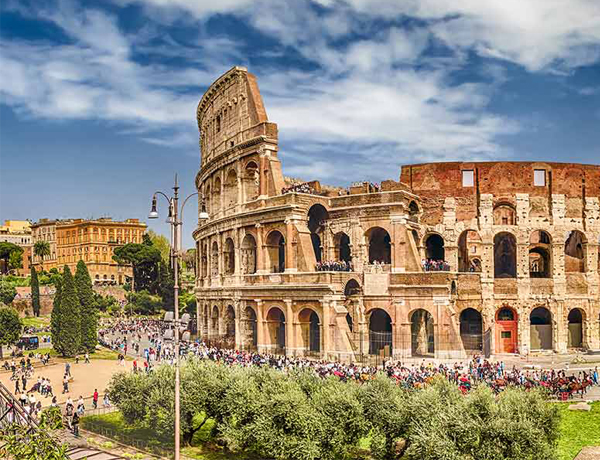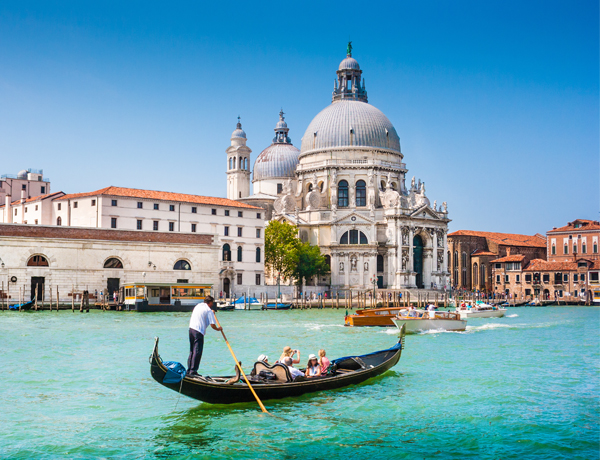Enchanting Italy has been a constant travel destination over millennia. Its attractions are many, commencing with its panoramic Mediterranean geography featuring myriad azure seascapes framed by craggy coast lines and dotted with ancient picturesque towns chiseled into its many cliffs.
Olive and lemon groves along with grape vines embellish the spectacular views. The light is bright and endowed with a special clarity which enhances further the human senses and appreciation of the overwhelming beauty. Italy’s weather is clement with generally sunny days and mild temperatures during spring and fall, with warmer days in summer. The winters are often agreeable in the south with large snow falls to be expected only in the Apennine Mountains, the northern areas and especially in the Alpine regions.
Is well known that food and eating is central to the Italian culture, that one thing that all Italians hold in common. Partaking of a meal with family or friends cements the bonds of love and friendships. Most people eat to live, while Italians live to eat. Hence, cooking and Italian cuisine have developed into a fine art over countless centuries. Who would enjoy a plate of pasta with a fine Italian wine?
While food is central to Italian culture; wine is at its core. Wine making and drinking is as old as Italy itself. The country is the largest wine producer in the world and a major consumer per capita as well. By 300AD wine had become a part of the Christian Eucharist thereby ingraining itself further into Italian custom.
The variety of soil and climate of the regions contribute significantly to the differences in the wines that they produce.
Just as a curiosity, government law regulates Italian wine. The DOC seen on the label (Denominazione di Origine Controllata) indicates a high-quality wine while DOCG indicates the very best quality wine. Vino di Tavola (Table wine) is generally unpretentious but often very good.
Let’s talk about a few well-known destinations:
Rome 
This unique capital city reclines regally on her famous seven hills. Its light is bright and stimulating, enhancing the outstanding architectural surroundings. This great marvel of antiquity served as mother to western civilization.Rome is a walking city with much to see and experience. Andiamo! (Let's go!)
Visitors can start a morning walk from the center of Rome in Piazza Venezia. Looming over the piazza is the Capitoline Hill, the most sacred of the seven hills of antiquity. Off to its flank is the Great Alter to the Nation with an equestrian statue of Vittorio Emmanuelle II at its center. Proceeding up the elegant steps to the right of the altar, which were designed by Michelangelo, one arrives at the summit of the Capitoline Hill which contains museums, the Campidoglio (City Hall) and an equestrian statue of Marcus Aralias. Beyond the Camdidoglio, we walk by the Arch on Septimius Severus which leads to the Roman Forum. Here was the site of power from which Rome ruled the entire known world. It is replete with ruins of temples, arches, the Curia (senate house) which can be viewed from the ancient road called Via Sacra. After spending most of the morning in the Forum we move out past the Arch of Titus and right of the Arch of Constantine, (largest arch of ancient Rome) to see before us the all inspiring Colosseum which, in ancient times, could seat up to 70,000 spectators. Visitors are allowed to enter and explore the interior where the games took place. Close by is the Domus Aurea (the golden house of Nero) that was the most elaborately decorated palace of its time. As it is now early afternoon it is time for a sumptuous Roman lunch at one of the nearby restaurants or merely a snack at one of the many stands to be found in the area.
The Vatican, Trastevere, Via Veneto-Borghese Gardens area, Piazza di Spagna-Via Condotti area, and Via del Corso-Piazza del Popolo area are fascinating parts of the city which will delight.
Florence
It was Florence that delivered mankind from the gloomy Dark Ages to the Age of Enlightenment called the Renaissance. This time of charm and grace was championed by her many known artists and writers such as da Vinci, Botticelli, Brunelleschi, Giotto, Ghiberti, Michelangelo, Dante, Boccaccio and Petrarca.Florence is a city of half a million people with most if its art treasures conveniently located in its historic center. The Arno dissects the city and most of the attractions are found on the right side of the river.
Many highlights of the city may be enjoyed while walking through its neighborhoods. Visitors may begin by touring the Centro Storico (historic center). Starting at The Ponte Vecchio which spans the Arno and is lined with many jewelry shops one is led to the Uffizi Galleries, the most important museum dedicated to the Renaissance. The Piazza della Signoria with its famous Palazzo is close by and is identified as the core of the city. A few more blocks and one finds Piazza del Duomo dominated by one of the largest domes ever built. It is accompanied by the baptistery (Ghiberti doors) and the bell tower. The rest of the day could be dedicated to a wonderful Tuscan lunch or a snack at the many eateries in the area.
This first excursion can be augmented by a visit to the Galleria dell’Accademia (statue of David by Michelangelo). On the left bank of the Arno is the Palazzo Pitti, the Boboli Gardens the Piazzale Michelangelo featuring a stupendous view of the city.

Venice
Venice is arguably the most beautiful city in the world. Her lacy and enchanting existence is a testament to an enduring miracle. She is a work of art that should never have been created for the reason that she stands on a shifting watery foundation. Yet, she continues to magically float in her lagoon, to the delight of all mankind.As Venice is famous for its canals, bridges and narrow streets, a visitor can travel by either water, by foot or a combination of both.
A convenient place to start touring is Piazza San Marco located in the center of Venice which features St Marks Basilica, the Doge’s Palace, the Bridge of Sighs and the famous bell tower. Standing close by and watching over Venice is a column with its winged lion. Here you can take a Gondola ride that can last up to an hour. The Grand Canal is the main water way lined by Venetian Gothic Palaces, museums and hotels. This can also be done along with the masses by using the vaporetto (municipal water buses). A visitor may take the vaporetto from St Mark’s and get off at the famous Rialto Bridge and then walk along the various calles (streets) to absorb the city sights and sounds. Along the way a stop at a local wine bar for a glass of wine and “cicchetti” (snacks) is suggested.
The neighboring islands of Murano and Burano are a 30-minute boat ride away from Venice. Murano is the undisputed world center for glass blowing that features a great sophistication and choice of glass objects for sale. Burano is known for its delicate handmade lace and has a lovely slow-paced fishing village atmosphere.
Ready to book your client for the Ultimate Italian Experience?
At Select Italy we use our expertise to design every itinerary according to your client’s preferences, ensuring the ultimate Italian experience.
Visit the Online Booking Platform where you can book full itineraries or a-la-carte services and earn bonus commission!
At Select Italy we use our expertise to design every itinerary according to your client’s preferences, ensuring the ultimate Italian experience.
Visit the Online Booking Platform where you can book full itineraries or a-la-carte services and earn bonus commission!

